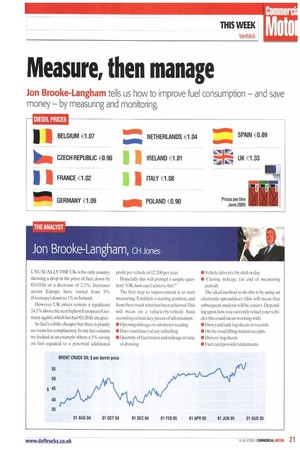Measure, then manage
Page 21

If you've noticed an error in this article please click here to report it so we can fix it.
Jon Brooke-Langham tells us how to improve fuel consumption — and save money — by measuring and monitoring.
UN USUALLY THE UK is the only country showing a drop in the price of fuel, down by €0.03/lit or a decrease of 2.2%. Increases across Europe have varied from 9% (Germany) down to 1% in Ireland.
However UK prices remain a significant 24.3% above the next highest European (Germany again), which has fuel €0.26/lit cheaper.
So fuel's a little cheaper but there is plainly no room for complacency In my last column we looked at an example where a 5% saving on fuel equated to a potential additional profit per vehicle of f2.200 per year.
Hopefully this will prompt a simple question:"OK, how can I achieve this?"
The first step to improvement is to start measuring. Establish a starting position, and from there track what has been achieved:This will mean on a vehicle-by-vehicle basis recording certain key pieces of information: • Opening mileage or odometer reading • Date (and time) of any refuelling • Quantity of fuel drawn and mileage at time of drawing • Vehicle driver(s) by shift or day • Closing mileage (at end of measuring period) The ideal method to do this is by using an electronic spreadsheet (this will mean that subsequent analysis will be easier). Depending upon how you currently refuel your vehicles this could mean working with: • Own yard tank log sheets or records • On the road tilling station receipts • Drivers' log sheets • Fuel card provider statements.










































































































































































































